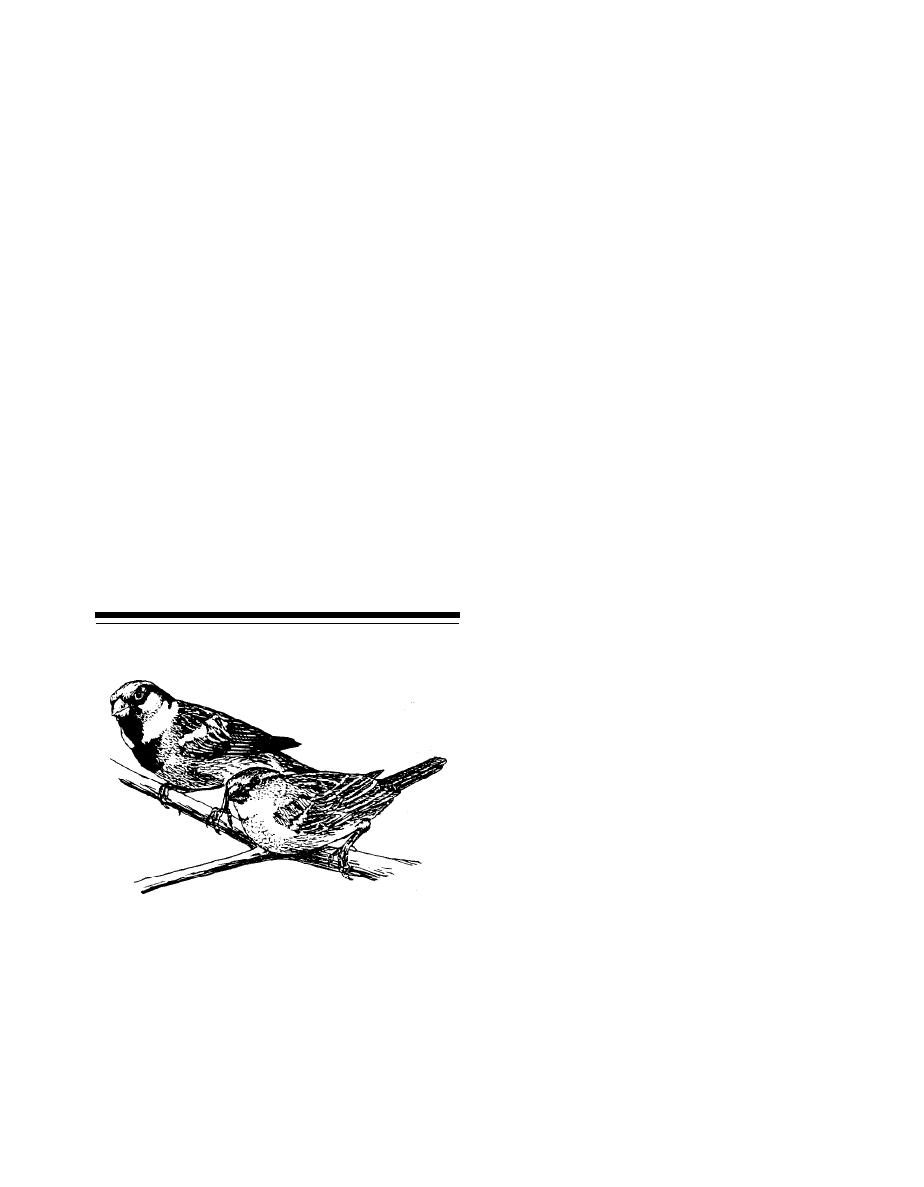

Custom Search
|
|

|
||
 The house sparrow is a brown, chunky bird five
cold weather begins in the fall, they begin forming
to six inches long. The male has a distinctive black
larger flocks. The major sources of food shift from
bib, white cheeks, a chestnut mantle around a gray
insects and fruits to grains, seeds, livestock rations,
crown, and chestnut upper wing covers. The female
and food in garbage. Roosting areas may shift from
and young birds have a gray breast, light eye stripe,
rural and suburban into cities and towns. Each day
and a streaked back.
they may fly up to 30 miles to their feeding sites. Each
starling eats about one ounce of food each day.
Habits of House Sparrows
Leaving their evening roost at sunrise, they travel
to feeding sites over well-established flight lines.
House sparrows average three broods per season
When they return just before sundown, they do not fly
with four to seven eggs per brood. Breeding can occur
straight in to their roost. They "stage" on high perches
in any month; through much of the country, it is most
such as trees, power lines, bridges, and towers. The
common from March through August. Eggs are
birds are quite social at these times and remain on pre-
incubated for about two weeks, and the young stay in
roost sites until after sunset, singing and calling to
the nest another two weeks.
each other.
The male usually selects the nest site. Nests are
Starlings are pests because of their high numbers.
bulky and roofed over, and located in trees and
Thousands or tens of thousands can roost at one site.
shrubs, on building ledges, in signs, on light fixtures,
Droppings at the roost site damage car finishes, tarnish
and under bridges. Nests often plug rain gutters or jam
buildings, drop on people below, and build up to such
power transformers.
levels that they become a health hazard; starlings have
Sparrows are aggressive and social birds and will
been responsible for outbreaks of a number of
often outcompete native species. They have no
diseases.
recognized migration patterns, and will stay in an area
When starlings roost in food processing plants or
as long as food and nest sites are available. Young
storage areas, they contaminate food. The birds
birds, however, move out of an area to establish new
consume large quantities of livestock feed and
territories. Flocks of juvenile birds and non-breeding
contaminate water at stockyards. The noise of a large
adults may sometimes travel four or five miles from
flock can be irritating.
nest sites to feeding areas. Sparrows are very tolerant
of human activity, and will not hesitate to set up
housekeeping in high traffic areas.
House sparrows feed preferentially on grain. They will
HOUSE SPARROWS
also feed on fruits, seeds, and garbage.
House sparrows can be pests in many situations.
Their droppings contaminate stored grain and bulk
food. Droppings and feathers can make hazardous,
unsanitary, and smelly wastes inside and outside of
buildings, on sidewalks, and under roosting sites.
Sparrows can also become a pest when one or a few
begin nesting inside a food plant, warehouse, mall, or
atrium.
The birds cause damage by pecking at rigid foam
insulation in buildings and nesting inside traffic lights.
They create a fire hazard by nesting in transformers
and power stations.
The house sparrow (Passer domesticus), also
They are a factor in the transmission of a number
of diseases, internal and external parasites. Most
called the English sparrow, was introduced into the
significantly, they are thought to be a major reservoir
United States in the 1850's. Populations now flourish
of St. Louis encephalitis.
all over the continental United States except in heavy
forests, mountains and deserts. It seems to prefer
OTHER BIRDS
human-altered habitats in cities and around farm
buildings and houses. In fact, while still one of the
The three birds most often pests in the United
most common birds, its numbers have fallen drastically
States in urban areas are pigeons, starlings, and house
since the 1920's when food and waste from horses was
sparrows. Other birds, from hawks to swallows, may
occasionally cause unexpected and unusual pest
unlimited.
Module Three Chapter 4, Pg 3
|
 |
|
 |
||